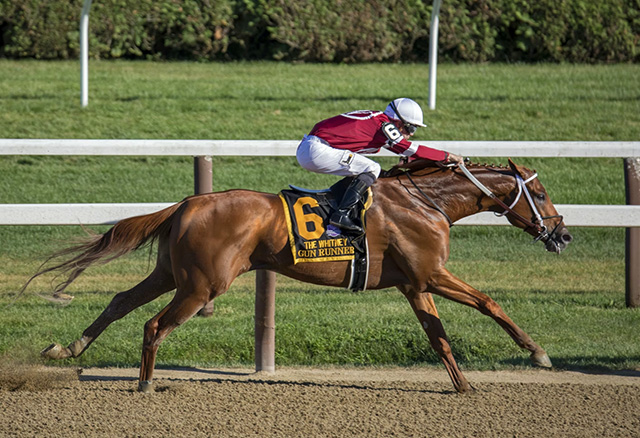This article provides a distilled overview of the major categories of horse racing: flat, jumps, harness, and endurance races.
Expect a concise yet thorough exploration of each type’s distinct nature, the required skill set, and their historical and cultural importance—all the essentials to satisfy your curiosity and deepen your knowledge of horse racing.
 sporting colors
sporting colorsExploring the Spectrum of Horse Racing Disciplines
Thoroughbred horse racing encompasses a broad spectrum of distinctive events, each presenting its compelling mix of skill, strategy, and thrill.
The sport showcases horses' versatility through high-speed flat and national hunt races that demand stamina and skill to navigate jumps.
The legacy of the best racing horses of all time is evident in thoroughbred racing, which unfolds a gripping story full of thrilling matchups and intense rivalry at various horse race meetings around the world, spanning continents from the United Kingdom's National Hunt Racing—featuring both steeplechases and national hunt flat races—to North America's thrilling stakes races.
The Thrill of Flat Racing
Flat racing, the captivating blend of velocity and precision, enthralls spectators around the globe.
This form of equestrian sport is distinguished by events where horses sprint along flat, obstacle-free surfaces, showcasing their swiftness and agility.
These races range from short dashes to longer middle-distance runs and endurance challenges for stayers, amplifying excitement with each hoofbeat over diverse lengths.
The intensity of competition in flat races escalates with its classification hierarchy ranging from Group 1 down to Listed Races — each level signifying more significant challenge and renown.
The atmosphere at Ascot Racecourse during events like the Gold Cup epitomizes this scale.
It’s a pinnacle Group 1 race drawing large crowds and members of the British Royal Family, adding regal splendor to an already prestigious occasion in flat racing.
The Challenge of Jumps Racing
In equestrian sports, jump racing stands out for its blend of excitement and demanding prowess.
This form of competition, often called National Hunt races, involves equine athletes leaping over barriers or fences across grass tracks.
Distinct from flat racing, which prioritizes velocity, jump racing evaluates a horse’s versatility and endurance and pairs it with the rider's strategic execution.
Categorization in jumps races considers horses' age and skill level to ensure equitable matchups.
Marquee events such as The Champion Hurdle and Cheltenham Gold Cup represent pinnacle achievements within Grade 1 jumps racing competitions.
Amidst these storied contests at Cheltenham Racecourse emanates an electrifying ambiance that perfectly captures the essence and revered status associated with National Hunt horse racing.
The Strategy Behind Harness Racing
Harness racing adds a distinctive flavor to the world of horse racing. Standardbred horses are harnessed to a lightweight carriage called a sulky in this variant.
These horses must haul this cart and consistently pace or trot during the race.
What distinguishes harness racing is its tactical nature. Drivers need to exhibit exceptional agility and skill in maintaining their horse’s pace while steering the sulky proficiently.
The outcome of each race highlights the driver's prowess, the horse's steadfastness, and their remarkable synergy, introducing an enthralling layer to traditional equestrian contests.
The Test of Endurance Racing
Endurance racing puts the rider and their horse to a grueling test, as they must traverse extensive distances spanning tens to hundreds of miles.
These races are designed to challenge both participants' physical limits of stamina, scrutinizing horses' perseverance across prolonged routes.
Arabian horses shine prominently in these endurance tests due to their exceptional qualities. They excel at enduring challenging courses, which proves their robustness and ability.
The spectacle is not just about a horse’s capacity to sustain speed but also reflects how adeptly riders conserve and manage the energy levels of their equine partners—a true testament to the grit and lasting power in the realm of endurance racing.
 gun runner
gun runnerClassifying the Competition: Understanding Race Levels
Gaining a richer understanding of horse racing involves familiarizing oneself with the different classes and levels within the sport, from maiden races, where horses embark on their competitive journeys, to the thrilling high-stakes environment of celebrated events like the Kentucky Derby and Breeders’ Cup.
Knowledge of these various stages can amplify enjoyment and broaden comprehension of this enthralling athletic endeavor for anyone involved in horse racing—as an owner, jockey, trainer, or avid fan.
Maiden Races: The Starting Gate
The journey to becoming a champion often begins at a maiden race. These races are the beginning level of horse racing, exclusively for horses who have yet to taste victory.
It’s here that fledgling competitors get their first taste of the racing world, starting their journey towards more significant challenges and higher stakes.
Maiden races come in different levels, such as maiden particular weight races, where horses are not eligible to be claimed.
A horse ‘breaking its maiden’ – winning its first race – is a moment of great excitement and promise.
Stories like Zippy Chippy, a horse famous for not winning any of its 100 race starts, highlight the challenge and unpredictability of maiden racing.
Climbing the Ladder with Claiming Races
Claiming races are a particularly engaging element of horse racing. Each participating horse is assigned a value that potential buyers can claim before the race if correctly registered.
This exciting mix of athletic competition and market activity adds an extra layer of strategy beyond just the on-track performance.
When involved in these races, there’s an intriguing point to consider: should your horse be claimed during the event, you would relinquish ownership immediately after its conclusion while still retaining any prize money earned by the horse.
For those who own and train horses, claiming races becomes a tactical game. Their goal is often to win and avoid having their prized competitors snatched away by rivals.
To foster fair play among contenders, different classes based on claiming price have been established within these events.
This guarantees that all owners and trainers compete under equitable financial investment and racetrack prowess conditions.
Allowance Races: Gaining Momentum
In the hierarchy of horse racing, allowance races are considered a notch above claiming races.
Horses in these events carry weights based on predetermined conditions such as age or previous victories. This setup is intended to level the playing field among competitors.
The critical difference between an allowance race and a claiming race is that horses in an allowance race aren’t up for purchase. With larger purses at stake, these races draw a more superior class of horses.
Allowance races serve as a stepping stone for horses who have notched some wins but are not quite ready to take on the top-tier competition, thereby providing them with opportunities for Development based on factors like experience and recent form within the racing sphere.
The Pinnacle of Horse Racing: Stakes Races
Stakes races sit at the apex of horse racing. These prestigious events feature top racehorses competing for significant purses, often subject to certain restrictions.
The stakes races are where the sport's giants battle for supremacy, with each victory adding another chapter to the annals of horse racing history.
Graded stakes races are considered the pinnacle of horse racing competition, attracting the sport's top contenders.
These races showcase the most elite athletes competing at the highest level. Some examples of graded stakes races include:
- The Kentucky Derby
- The Preakness Stakes
- The Belmont Stakes
- The Breeders’ Cup Classic
The Triple Crown series, comprising the Kentucky Derby, the Preakness Stakes, and the Belmont Stakes, is the pinnacle of stakes racing.
With its once-record purse of $6 million, the Breeders' Cup Classic is part of the elite Grand Slam of horse racing. It showcases the immense rewards and prestige associated with stakes race victories.


 Current Events
Current Events